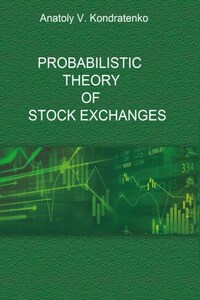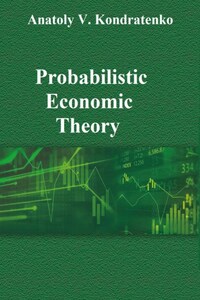Reviewer:
DSc S.I. Parinov
All rights reserved. No part of the book or whole book may be reproduced or transmitted in any form or by any means without the written permission of the author.
Methods of theoretical physics, classical and quantum mechanics are used to develop classical and quantum models of economies and to derive their equations of motion that describe economy evolution in time, namely, Lagrange and Schrödinger equations correspondingly.
This monograph may seem interesting to everyone who is engaged in research in economics, finance, econophysics or physical economics, as well as to professional investors and stock traders.
This is the first monograph in a series devoted to the development of probabilistic economic theory (Kondratenko, 2005, 2015, 2021). It outlines the fundamental concepts of this theory.
In the market economy major active players (or agents, or subjects), i.e. buyers and sellers of goods and commodities, behave to a certain extent in a deterministic way thus subordinating their behavior in the market to some strict economic laws. The fact that these laws are of a descriptive nature, and they have not yet been expressed in a precise mathematic language, is not of key importance in this case.
Every rational player or market subject acts in the market in accordance with a strict rule of obtaining maximum profit or benefit or some other criterion of optimality for him or her and in this respect market economic systems resemble physical systems where all players, members, and elements of the system act also in accordance with some principles of maximization.
The main drive of our research is that we assume general possibility to develop dynamic models for relatively simple market economic systems consisting of an economic subsystem or simply an economy with a certain number of buyers and sellers and its external environment with certain interactions between economy agents, and between the economy and environment. In this case, it is supposed that it can be performed by the analogy with the method of developing theoretical models of physical systems consisting of a system of interacting material particles in the external fields or external environment [1, 2]. Moreover, it is assumed that equations of motion derived for physical systems in the physical space are quite a good initial approximation for equations of motion of modeled economic systems in some price space.
Let’s give the following reasons to substantiate such an approach. Let p(t) be a trajectory of movement of the market subject in a price space, in other words, it is price p of a commodity set for by the subject at a moment t. By setting prices this way, buyers and sellers who act as homo negotians (a negotiating man) in a physical modeling aim at maximum satisfaction of their strive for profit, i.e. for such price at which interests of both buyers and sellers and, considering external environment and the whole system in general, are satisfied in an optimal way. It is here that one can see similarity of the movement of economy (described by trajectories p(t)) to the moving of material particles of the physical system (described by trajectories x(t)), which is also subject to a certain principle of maximization. This is what our confidence in conceptual possibility of developing a dynamic theory of economic systems in a price space by the analogy with a dynamic theory of physical systems in physical space is based on. We also admit that in spite of the difference between the qualities of the physical and price spaces along with the qualities of economic and physical systems, the reasonable starting point in the study of economic systems dynamics are equations of motion for a physical prototype, i.e. the type of equations of both systems in their spaces will be the same, though the essence of parameters and potentials in them will be completely different. It is a usual case in physics when one and the same equation describes different systems. For example, the equation of harmonic oscillator describes motion of both simple pendulum and electromagnetic wave. In other words, formal similarity of the equations does not mean equality of the systems which they describe.
In physics a wide experience in calculating physical systems of different degree of complexity with different interaction between members of the system and the system with external environment has been accumulated. It makes sense trying to find a way to use these achievements in finding solutions of economic problems. In case such an activity were successful, there would appear an opportunity of numerical research of the influence of both different internal and external factors on the behavior of each economic agent and on the results of activity of the whole economic system with the help of computer calculations of physical models. Economics (more exactly – theoretical economics) would obtain the most powerful research device the opportunities of which could be compared with the result of the discovery of equations of motion of the physical systems.










